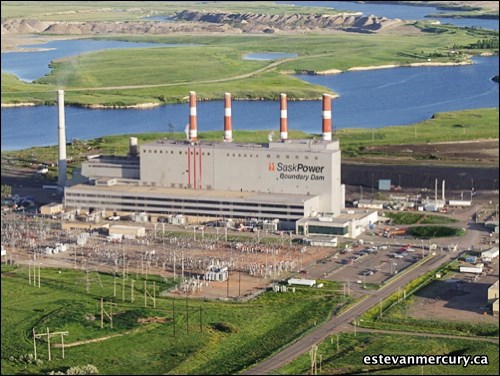The pieces are coming together quite efficiently, on time and within budget.
That was the word coming from Robert Watson, SaskPower's CEO, who spoke with The Mercury Tuesday morning.
In fact, the Boundary Dam Unit 3 rebuild and the accompanying integrated carbon capture and sequestration project could see Unit 3 back on stream as early as October, followed by a planned and gradual integration of the carbon capture unit. In fact, that has already begun, with the first few stages of the amalgamation of the two project islands completed and operational.
"We've already started commissioning. It's a formal process with an independent crew. SaskPower will then inspect the work that has been done with the contractor (SNC Lavalin) and then the operations team from SaskPower will take it over," said Watson.
That should happen by the spring of 2014, as scheduled.
"It's all about checks and balances. It's a world-class process. Right now the Boundary Dam Unit 3 rebuild is 90 per cent done. The clean up will start in September," said Watson, referring to the two phases of the carbon capture project that should come in within the expected $1.24 billion budget.
"The rebuild project has been totally transparent," he added.
There are two project managers on site at the carbon capture island in the separate facility that houses noxious gases capture materials and equipment, including a key 140 foot CO2 capture vessel.
In the Boundary Dam plant, the Unit 3 rebuild has seen an entire new generator installed, which boosted original electrical power production from about 130 megawatts to 160 megawatts. Once the carbon capture process begins, the power production capabilities are expected to level off at between 110 and 120 megawatts.
It's too soon to speculate as to when Units 4, 5 and 6 will be outfitted with similar capabilities to capture carbon dioxide, but Watson suggested the effectiveness of the Unit 3 retrofit should be known by the end of 2015, leading to the possibility of another major project slated for 2016. He further suggested that subsequent rebuilds and retrofits should come in at around 30 per cent less than this pilot project.
Officials from the federal environment department are making their way to Estevan soon to be brought up to date on all aspects of the project that not only captures carbon dioxide but also sulfur dioxide and flyash, which also have resale value.
Watson said there is already plenty of interest in the carbon dioxide gas as an agent for enhanced oil recovery in the nearby oilpatch, and, in fact, any CO2 captured in the future with the outfitting of Units 4 through 6 will have buyers. The million tonnes of CO2 captured by the Unit 3 project, are already spoken for by an international oil production company, Cenovus Energy Inc.
The capture and storage process is now being heralded by governments and researchers around the world, said Watson. SaskPower officials are being invited to speak at technical conferences and gatherings all over. It's to the point they are having to be selective as to where they go and who they speak to. There are intellectual properties to protect, and SaskPower is certainly seeking prospective partners who might be willing to invest in the future, such as Hitachi, which has already partnered with them at the accompanying $60 million commercial testing facility that is under construction at the nearby Shand Power Station.
"We'll educate those who wish to join the consortium and I expect that once we start actually capturing carbon dioxide, sometime around November, there will be a whole lot of other companies and countries making some decisions," Watson said.
The Shand experimental opportunities make such an interesting addition to the potential investment package, it could be difficult to resist.
In the meantime, the issues regarding possible airborne asbestos contamination on the BD3 rebuild site have been put to rest with the hatchways that were suspected of containing the asbestos having been removed, cleaned and replaced. Two stringent independent air quality tests were conducted and everyone was assured that airborne asbestos levels were well below any alarm levels. The first detection of stray asbestos was made a few weeks ago, which led to a temporary shutdown of a portion of the rebuild site. Those concerns have now been addressed and the incident has not led to any significant change to the commissioning schedule, the CEO said.



